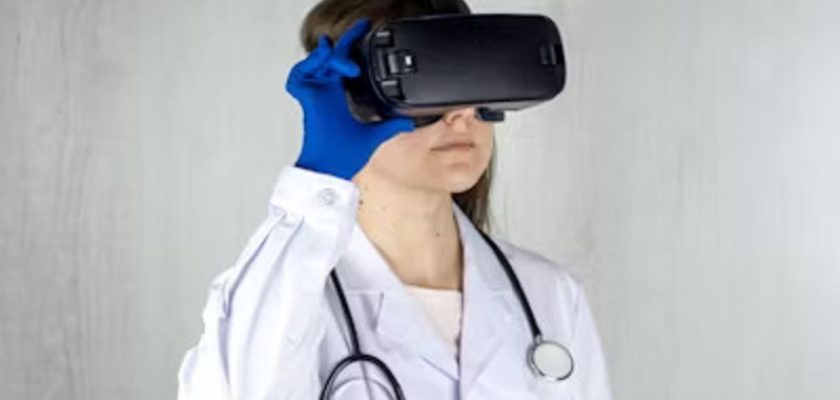The Role of Virtual Reality in Transforming Healthcare Experiences
- Updated on: May 7, 2025
- Published on Jul 7, 2023

In recent years, virtual reality (VR) has emerged as a groundbreaking technology that has the potential to revolutionize various industries. One such industry that stands to benefit immensely from VR is healthcare. Virtual reality in healthcare has opened up a whole new realm of possibilities, transforming the way medical professionals diagnose, treat, and educate patients. In this article, we delve into the innovative applications of VR in healthcare and explore how it is reshaping the future of medicine.
Benefits of Virtual Reality in Healthcare
Pain management and distraction during medical procedures
Reduction of anxiety and fear: Virtual reality has been shown to significantly reduce anxiety and fear in patients undergoing various medical procedures. By immersing patients in virtual environments, VR distracts them from the medical setting, helping to alleviate stress and discomfort.
Use of immersive environments to divert attention: VR technology offers the ability to create immersive and engaging environments that can divert patients’ attention away from pain during medical procedures. By directing their focus to the virtual environment, VR can help reduce the perception of pain and enhance overall patient comfort.
Rehabilitation and physical therapy
Enhancing motor skills and coordination: Virtual reality can be utilized in rehabilitation and physical therapy to enhance motor skills and coordination. By providing interactive and engaging simulations, patients can practice movements and exercises in a controlled virtual environment, facilitating the recovery process.
Simulating real-world scenarios for practice: VR enables the simulation of real-world scenarios, allowing patients to practice activities of daily living or specific tasks relevant to their rehabilitation. This provides a safe and controlled environment for patients to gain confidence, improve their abilities, and enhance their functional outcomes.
Medical education and training
Realistic simulations for surgical training: Virtual reality offers realistic surgical simulations that enable medical students and professionals to practice surgical techniques in a virtual environment. This allows for repetitive practice, skill development, and the opportunity to learn from mistakes without risk to real patients.
Improving diagnostic skills through interactive case studies: VR can also be used to enhance diagnostic skills through interactive case studies. Medical students and practitioners can engage in virtual patient scenarios, honing their ability to make accurate diagnoses, develop treatment plans, and improve their overall clinical decision-making.
Advantages of Virtual Reality in Healthcare
Immersive training simulations for healthcare professionals
Virtual reality enables healthcare professionals to engage in realistic and immersive training simulations. They can practice complex medical procedures, surgical techniques, and emergency scenarios in a safe and controlled environment. This enhances their skills, improves decision-making abilities, and boosts overall competence.
Pain management therapies
Virtual reality has proven to be effective in alleviating pain and discomfort during medical procedures or chronic conditions. By immersing patients in virtual environments, such as serene landscapes or engaging activities, it distracts their attention from pain, reducing the need for medication and enhancing their overall well-being.
Anxiety reduction techniques for patients
Many patients experience anxiety and stress in medical settings. Virtual reality can help alleviate these feelings by providing immersive experiences that divert attention and create a calming environment. It can transport patients to soothing virtual environments, engage them in relaxing activities, or guide them through mindfulness exercises, promoting a sense of calm and reducing anxiety levels.
Applications of Virtual Reality in Healthcare
Telemedicine and remote patient care
Virtual reality enables remote consultations and medical procedures, bridging the distance between healthcare providers and patients. It allows healthcare professionals to examine patients virtually, provide remote guidance, and deliver specialized treatments, improving access to healthcare, particularly in underserved areas.
Rehabilitation and physical therapy
Virtual reality is used in rehabilitation settings to enhance physical therapy outcomes. Patients can engage in interactive exercises and simulations that promote movement, coordination, and balance. This technology offers a motivating and engaging platform for rehabilitation, allowing patients to track their progress and improve their recovery process.
Surgical planning and simulation
Virtual reality aids in surgical planning by creating 3D models of patient anatomy, allowing surgeons to visualize and practice procedures beforehand. It enhances precision, reduces risks, and improves surgical outcomes. Additionally, virtual reality simulations provide a platform for surgical training, allowing surgeons to refine their skills in a realistic and immersive environment.
Mental health treatments
Virtual reality is increasingly utilized in the field of mental health to provide therapeutic interventions. It can simulate exposure therapy for phobias, create immersive environments for stress reduction and relaxation, and offer cognitive training exercises for mental health disorders. Virtual reality-based treatments have shown promising results in reducing symptoms and improving overall mental well-being.
Impact of Virtual Reality on Healthcare Experiences
Enhancing patient care and outcomes
Virtual reality technology enhances the quality of patient care by providing personalized and engaging experiences. It improves treatment adherence, patient satisfaction, and overall healthcare outcomes. By addressing pain, anxiety, and rehabilitation challenges, it contributes to a more positive patient experience and faster recovery.
Improving medical education and training
Virtual reality revolutionizes medical education by offering realistic and interactive training experiences. It allows students and healthcare professionals to practice procedures repeatedly, learn from mistakes, and gain confidence in a risk-free environment. This immersive learning approach enhances knowledge retention and prepares healthcare providers for real-world challenges.
Facilitating remote collaboration and consultation
Virtual reality enables remote collaboration among healthcare professionals, allowing them to consult and collaborate on cases irrespective of geographical locations. It enhances interdisciplinary communication, facilitates knowledge sharing, and promotes collaborative decision-making, ultimately improving the quality of care provided to patients.
By harnessing the advantages of virtual reality and exploring its diverse applications, healthcare experiences are being transformed, benefiting both patients and healthcare professionals.
Challenges and Limitations
Cost and accessibility
Expensive VR equipment and software: One of the main challenges in implementing VR in healthcare is the high cost associated with acquiring VR equipment and software. VR headsets, tracking devices, and computing systems can be expensive, making it difficult for many healthcare facilities to afford them. The cost of licenses for VR software and applications can also be a limiting factor.
Availability in healthcare facilities: Another challenge is the availability of VR technology in healthcare facilities. Not all hospitals or clinics have the necessary infrastructure or resources to integrate VR into their practices. This lack of availability limits the potential benefits that VR can bring to patients and healthcare professionals.
User experience and comfort
Motion sickness and disorientation: VR experiences can sometimes induce motion sickness or disorientation in users. The sensory disconnect between the virtual world and the user’s physical movements can cause discomfort and make it challenging for some individuals to fully engage in VR therapy. Motion sickness can be a significant barrier to utilizing VR in healthcare, especially for patients who are already prone to dizziness or nausea.
Designing comfortable and user-friendly interfaces: Creating comfortable and user-friendly interfaces is crucial for successful VR adoption in healthcare. VR headsets should be lightweight, well-padded, and properly fitted to minimize discomfort during prolonged use. Interfaces and controls should be intuitive and easy to navigate, ensuring that both patients and healthcare professionals can operate the VR systems effectively.
Ethical considerations
Patient privacy and data security: VR technology collects and stores sensitive data about patients’ experiences and behaviors. Ensuring the privacy and security of this data is essential to protect patient confidentiality and comply with regulations. Healthcare organizations need to establish robust data protection measures and ensure that patient information is securely stored and transmitted.
Potential for addiction or overreliance on VR therapy: As with any technology, there is a potential risk of individuals developing addiction or overreliance on VR therapy. Excessive use of VR for treatment or training purposes may lead to dependency and the neglect of other essential aspects of healthcare. It is crucial for healthcare professionals to monitor and regulate the use of VR to maintain a balanced approach to patient care.
In conclusion, virtual reality is revolutionizing the field of healthcare by providing innovative solutions to long-standing challenges. The applications of VR in medical training, pain management, phobia treatment, and telemedicine are just the beginning. With ongoing advancements and increasing adoption, virtual reality has the potential to reshape the future of medicine, delivering improved patient care, enhanced education, and transformative medical breakthroughs.


